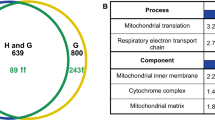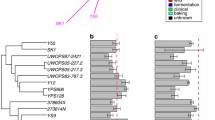Abstract
Using a new genetic selection approach in yeast termed fitness-based interferential genetics (FIG), genes that are in an antagonistic relationship with the Sir complexes were selected. Many of the functionally well-defined genes belong to various aging processes occurring in this organism. Three genes are somehow involved in glucose utilization (HXT4,YIL107c, EMI2). Another gene, CDC25, encodes the main regulator of the cyclic AMP pathway in response to glucose. STM1 has been implicated in the control of apoptosis, and indeed, this work shows that disruption of this gene results, among other phenotypes, in resistance to aging. LCB4, encoding a sphingoid bases kinase is linked to the cell integrity pathway. Two other genes, FHL1 and PEP5, are involved in the control of ribosome formation and vacuole biogenesis, respectively; and five genes, presently having unknown functions, could be new potentially interesting candidates for further studies in relation to yeast replicative aging. It is proposed that most, if not all, selected genes are downregulated by the Sir complexes. In addition to changing our view of the mechanisms used by the Sir complexes for extending life span in yeast, these findings could contribute to a better understanding of the role of the Sir complexes in the higher eukaryotes.



Similar content being viewed by others
References
Aguilaniu H, Gustafsson L, Rigoulet M, Nyström T (2003) Asymmetric inheritance of oxidatively damaged proteins during cytokinesis. Science 299:1751–1753
Arking R (1998) Biology of aging: observation and principles. Sinauer Associates, Sunderland, MA
Ashrafi K, Sinclair D, Gordon JI, Guarente L (1999) Passage through stationary phase advances replicative aging in Saccharomyces cerevisiae. Proc Natl Acad Sci USA 96:9100–9105
Bettiga M, Calzari L, Orlandi I, Alberghina L, Vai M (2004) Involvement of the yeast metacaspase Yca1 in ubp10Δ -programmed cell death. FEMS Yeast Res 5:141–147
Bitterman KJ, Medvedik O, Sinclair DA (2003) Longevity regulation in Saccharomyces cerevisiae: linking metabolism, genome stability, and heterochromatin. Microbiol Mol Biol Rev 67:376–399
Boles E, Gohlmann HW, Zimmermann FK (1996) Cloning of a second encoding 5-phosphofructo-2-kinase in yeast, and characterization of mutants strains without fructose-2,6-biphosphate. Mol Microbiol 20:65–76
Cherel I, Thuriaux P (1995) The IFH1 gene product interacts with a fork head protein in Saccharomyces cerevisiae. Yeast 11:261–270
Colombo S, Ronchetti D, Thevelein JM, Winderickx J, Martegani E (2004) Activation state of the Ras2 protein and glucose-induced signaling in Saccharomyces cerevisiae. J Biol Chem 279:46715–46722
Daniel J (1993) Potentially rapid walking in cellular regulatory networks using the gene–gene interference method in yeast. Mol Gen Genet 240:245–257
Daniel J (1996a) Detection of antagonistic cellular regulatory functions by the gene–gene interference method in yeast. Curr Genet 29:114–121
Daniel J (1996b) Measuring the toxic effects of high gene dosage on yeast cells. Mol Gen Genet 253:393–396
D’mello NP et al (1994) Cloning and characterization of LAG1, a longevity-assurance gene in yeast. J Biol Chem 269(22):15451–15459
Francois J, Van Schaftingen E, Hers HG (1984) The mechanism by which glucose increases fructose 2,6-bisphosphate concentration in Saccharomyces cerevisiae. A cyclic-AMP-dependent activation of phosphofructokinase 2. Eur J Biochem 145(1):187–193
Frantz JD, Gilbert W (1995) A yeast gene product, G4p2, with a specific affinity for quadruplex nucleic acids. J Biol Chem 270(16):9413–9429
Friant S, Lombardi R, Schmelzle T, Hall MN, Riezman H (2001) Sphingoid base signaling via Pkh kinases is required for endocytosis in yeast. EMBO J 20(23):6783–6792
Gangloff S, Soustelle C, Fabre F (2000) Homologous recombination is responsible for cell death in the absence of the Sgs1 and Srs2 helicases. Nat Genet 25:192–194
Gompertz B (1825) On the nature of the function expressive of the law of human mortality and a new mode of determining the value of life contingencies. Philos Trans R Soc Lond 115:513–585
Granot D, Dai N (1997) Sugar induced cell death in yeast is dependent on the rate of phosphorylation as determined by Arabidopsis thaliana hexokinase. Cell Death Differ 4(7):555–559
Granot D, Levine A, Dor-Hefetz E (2003) Sugar-induced apoptosis in yeast cells. FEMS Yeast Res 4:7–13
Guillas I et al (2001) C26-CoA-dependent ceramide synthesis of Saccharomyces cerevisiae is operated by Lag1p and Lac1p. EMBO J 20(11):2655–2665
Hayashi N, Murakami S (2002) STM1, a gene which encodes a guanine quadruplex binding protein, interacts with CDC13 in Saccharomyces cerevisiae. Mol Genet Genomics 267:806–813
Heo SJ et al (1999) Bloom’s syndrome gene suppresses premature ageing caused by Sgs1 deficiency in yeast. Genes Cells 4:619–625
Herker E et al (2004) Chronological aging leads to apoptosis in yeast. J Cell Biol 164(4):501–507
Hermann-Le Denmat S, Werner M, Sentenac A, Thuriaux P (1994) Suppression of yeast RNA polymerase III mutations by FHL1, a gene coding for a fork head protein involved in rRNA processing. Mol Cell Biol 14(5):2905–2913
Ito H, Fufuda Y, Murata K, Kumura A (1983) Transformation of intact yeast cells treated with alkali cations. J Bacteriol 153:163–168
Jenkins GM, Hannun YA (2001) Role for de novo sphingoid base biosynthesis in the heat-induced transient cell cycle arrest of Saccharomyces cerevisiae. J Biol Chem 276(11):8574–8581
Jiang JC, Kirchman PA, Allen M, Jazwinski SM (2004) Suppressor analysis points to the subtle role of the LAG1 ceramide synthase gene in determining yeast longevity. Exp Gerontol 39(7):999–1009
Kaeberlein M, McVey M, Guarente L (1999) The SIR2/3/4 complex and SIR2 alone promote longevity in Saccharomyces cerevisiae by two different mechanisms. Genes Dev 13:2570–2580
Kaeberlein M, Kirkland KT, Fields S, Kennedy BK (2004) Sir2-independent life span extension by calorie restriction in yeast. PLOS Biol 2(9) (online e296)
Kennedy BK et al (1997) Redistribution of silencing proteins from telomeres to the nucleus is associated with extension of life span in S. cerevisiae. Cell 89:381–391
Kennedy BK, Austriaco NR, Guarente L (1994) Daughter cells of S. cerevisiae from old mothers display a reduced life-span. J Cell Biol 127:1985–1993
Kennedy BK, Austriaco NR, Zhang J, Guarente L (1995) Mutation in the silencing gene SIR4 can delay aging in S. cerevisiae. Cell 80:485–496
Kim S, Fyrst H, Saba J (2000) Accumulation of phosphorylated sphingoid long chain bases results in cell growth inhibition in Saccharomyces cerevisiae. Genetics 156:1519–1529
Laun P et al (2001) Aged mother cells of Saccharomyces cerevisiae show markers of oxidative stress and apoptosis. Mol Microbiol 39(5):1166–1173
Ligr M et al (2001) The proteasomal substrate Stm1 participates in apoptosis-like cell death in yeast. Mol Biol Cell 12:2422–2432
Lin SJ, Defossez P-A, Guarente L (2000) Requirement of NAD and SIR2 for life-span extension by calorie restriction in Saccharomyces cerevisiae. Science 289:2126–2128
Lutfiyya LL et al (1998) Characterization of three related glucose repressors and genes they regulate in Saccharomyces cerevisiae. Genetics 150:1377–1391
Mintzer KA, Field J (1999) The SH3 domain of the S. cerevisiae Cdc25p binds adenylyl cyclase and facilitates Ras regulation of cAMP signalling. Cell Signal 11(2):127–135
Nagiec MM, Skrzypek M, Nagiec E, Lester RL, Dickson RC (1998) The LCB4 (YOR171c) and LCB5 (YLR260w) genes of Saccharomyces encode sphingoid long chain base kinases. J Biol Chem 273:19437–19442
Nelson LD, Musso M, Van Dyke MW (2000) The yeast STM1 gene encodes a purine motif triple helical DNA-binding protein. J Biol Chem 275:5573–5581
Obeid LM, Okamoto Y, Mao C (2002) Yeast sphingolipids: metabolism and biology. Biochim Biophys Acta 1585:163–171
Orlandi I, Bettiga M, Alberghina L, Vai M (2004) Transcriptional profiling of ubp10 null mutant reveals altered subtelomeric gene expression and insurgence of oxidative stress response. J Biol Chem 279(8):6414–6425
Rattan SI (1991) Protein synthesis and the components of protein synthetic machinery during cellular aging. Mutat Res 256(2–6):115–125
Reifenberger E, Boles E, Ciriacy M (1997) Kinetic characterization of individual hexose transporters of Saccharomyces cerevisiae and their relation to the triggering mechanisms of glucose repression. Eur J Biochem 245(2):324–333
Rogina B, Helfand SL (2004) Sir2 mediates longevity in the fly through a pathway related to calorie restriction. Proc Natl Acad Sci USA 101:15998–16003
Sambrook J, Fritsch EF, Maniatis T (1989) Molecular cloning: a laboratory manual, 2nd edn. Cold Spring Harbor Laboratory Press, Cold Spring Harbor, NY
Sherman F, Fink G, Hicks J (1987) Methods in yeast genetics: laboratory course manual. Cold Spring Harbor Laboratory Press, Cold Spring Harbor, NY
Sinclair DA, Guarente L (1997) Extrachromosomal rDNA circles—a cause of aging in yeast. Cell 91:1033–1042
Sinclair DA, Mills K, Guarente L (1997) Accelerated aging and nucleolar fragmentation in yeast sgs1 mutants. Science 277:1313–1316
Stearns SC, Ackermann M, Doebeli M, Kaiser M (2000) Experimental evolution of aging, growth, and reproduction in fruit flies. Proc Natl Acad Sci USA 97:3309–3313
Sun H, Bennett RJ, Maizels N (1999) The Saccharomyces cerevisiae Sgs1 helicase efficiently unwinds G–G paired DNAs. Nucleic Acids Res 27:1978–1984
Unterluggauer H, Hampel B, Zwerschke W, Jansen-Düre P (2003) Senescence-associated cell death of human endothelial cells: the role of oxidative stress. Exp Gerontol 38(10):1149–1160
Vaupel JW et al (1998) Biodemographic trajectories of longevity. Science 280:855–860
Wach A, Brachat A, Pöhlmann R, Philippen P (1994) New heterologous modules for classical or PCR-based gene disruptions in S. cerevisiae. Yeast 10:1793–1808
Zhang X, Skrzypek MS, Lester RL, Dickson RC (2001) Elevation of endogenous sphingolipid long-chain base phosphates kills Saccharomyces cerevisiae cells. Curr Genet 40:221–233
Zhu Y, Zou S, Wright DA, Voytas DF (1999) Tagging chromatin with retrotransposons: target specificity of the Saccharomyces Ty5 retrotransposon changes with the chromosomal localization of Sir3p and Sir4p. Genes Dev 13:2738–2749
Acknowledgements
This work was supported by the Centre National de la Recherche Scientifique (France). I thank L. Belcour and A. Sainsard for their kind hospitality.
Author information
Authors and Affiliations
Corresponding author
Additional information
Communicated by C. Hollenberg
Rights and permissions
About this article
Cite this article
Daniel, J. Sir-dependent downregulation of various aging processes. Mol Genet Genomics 274, 539–547 (2005). https://doi.org/10.1007/s00438-005-0040-5
Received:
Accepted:
Published:
Issue Date:
DOI: https://doi.org/10.1007/s00438-005-0040-5




